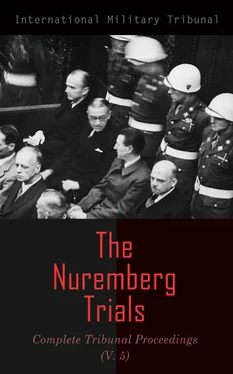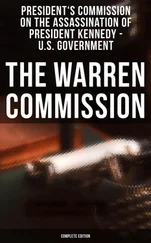“When Inge had entered the waiting room, she experienced an extraordinary incident. From the doctor’s consulting room she could hear the sound of crying. She heard the voice of a young girl, ‘Doctor, doctor, leave me alone.’
“Then she heard the scornful laughter of a man. And then, all of a sudden it became absolutely silent. Inge had listened breathlessly.
“ ‘What can be the meaning of all this?’ she asked herself, and her heart was pounding. And again she thought of the warning of her leader in the League of German Girls.
“Inge had already been waiting for an hour. Again she takes the journals in an endeavor to read. Then the door opens. Inge looks up. The Jew appears. She screams. In terror she drops the paper. Horrified she jumps up. Her eyes stare into the face of the Jewish doctor. And this face is the face of the Devil. In the middle of this devil’s face is a huge crooked nose. Behind the spectacles gleam two criminal eyes. Around the thick lips plays a grin, a grin that means, ‘Now I have you at last, you little German girl!’
“And then the Jew approaches her. His fat fingers snatch at her. But now Inge has got hold of herself. Before the Jew can grab hold of her, she smacks the fat face of the Jew doctor with her hand. One jump to the door. Breathlessly Inge runs down the stairs. Breathlessly she escapes from the Jew house.”
Comment is almost unnecessary on a story like that, read by children of the age of those who are going to read the books you have seen.
Another picture which I have included in the book is a picture, of course of the defendant, and the script opposite that picture, which appears on Page 70 of the document book, includes the words—and I quote from the last but one paragraph: “Without a solution of the Jewish question there will be no salvation for mankind.”
The page itself contains an account of how some boys attended one of his speeches:
“That is what he shouted to us. We all understood him. And when, at the end, he shouted, ‘Sieg-Heil for the Führer,’ we all acclaimed him with tremendous enthusiasm. Streicher spoke for two hours that time. To us it seemed to have been but a few minutes.”
One can begin to see the effect that all this was having from the columns of Der Stürmer itself. In April 1936 there appears only one letter—many others appear in other copies from children of all ages—I quote the third paragraph of this letter, the letter signed by the boys and girls of the National Socialist Youth Hostel at Gross-Möllem:
“Today we saw a play on how the Devil persuades the Jew to shoot a conscientious National Socialist. In the course of the play the Jew did it, too. We all heard the shot. We would have all liked to jump up and arrest the Jew. But then the policeman came and after a short struggle took the Jew along. You can imagine, dear Stürmer, that we heartily cheered the policeman. In the whole play not one name was mentioned, but we all knew that this play represented the murder by the Jew Frankfurter. We were very sad when we went to bed that night. None felt like talking to the others. This play made it clear to us how the Jew sets to work.”
My Lord, that book is already in evidence as I have stated. It is Exhibit GB-170 (Document M-25).
To conclude, I would draw the attention of the Tribunal again only to his authority as a Gauleiter. It appears in the Organization Book of the NSDAP for 1938—which is already in as Exhibit USA-430—in the description of the duties and authority of Gauleiter: The Gauleiter bears over-all responsibility to the Führer for the sector of sovereignty entrusted to him. The rights, duties, and jurisdiction of the Gauleiter result primarily from the mission assigned by the Führer and, apart from that, from detailed direction.
His association with the Führer and with the other defendants—or some of the other defendants—can be seen from the newspapers. On the occasion of his 50th birthday Hitler paid a visit to Nuremberg to congratulate him. That was on the 13th of February 1935. The account of that meeting is published in the Völkischer Beobachter of that date, and I quote as follows:
“Adolf Hitler spoke to his old comrade in arms and the latter’s followers in words which went straight to their hearts. By way of introduction he remarked that it was a special pleasure for him to spend, on this day of honor to Julius Streicher, a short while in Nuremberg, the town of battle-steeled National Socialist solidarity, within the circle of the veteran standard-bearers of the National Socialist idea.
“Just as they all, during the years of misery, had unshakeably believed in the victory of the Movement, so his friend and comrade in arms, Streicher, had stood faithfully at his side at all times. It had been this unshakeable belief that had moved mountains.
“For Streicher it would surely be an inspiring thought that this 50th anniversary meant to him not only the turn of a half century, but also of a thousand years of German history. He had in Streicher a comrade of whom he could say that here in Nuremberg was a man who would never waver for a single second and who would unflinchingly stand behind him in every situation.”
That is Document M-8 and becomes Exhibit GB-182.
The next document (M-22) is a letter from Himmler published in Der Stürmer of April 1937. That edition is already Exhibit USA-258.
“When in future years the history of the reawakening of the German people is written and the next generation is already unable to understand that the German people were once friendly to the Jews, it will be recognized that Julius Streicher and his weekly paper Der Stürmer contributed a great deal toward the enlightenment regarding the enemy of mankind.”—Signed—“The Reichsführer SS, H. Himmler.”
That is Exhibit USA-258. A number of these documents are already in evidence in the bound volumes.
Lastly, we have a letter from Baldur von Schirach, the Reich Youth Leader, published in Der Stürmer of March 1938 (Document M-45, Exhibit USA-260):
“It is the historical merit of Der Stürmer to have enlightened the broad masses of our people in a popular way as to the Jewish world danger. Der Stürmer is right in not carrying out its task in a purely aesthetic manner, for Jewry has shown no regard for the German people. We have, therefore, no reason for being considerate toward our worst enemy. What we fail to do today, the youth of tomorrow will have to suffer for bitterly.”
My Lord, it may be that this defendant is less directly involved in the physical commission of the crimes against Jews, of which this Tribunal have heard, than some of his co-conspirators. The submission of the Prosecution is that his crime is no less the worse for that reason. No government in the world, before the Nazis came to power, could have embarked upon and put into effect a policy of mass extermination in the way in which they did, without having a people who would back them and support them and without having a large number of people, men and women, who were prepared to put their hands to their bloody murder. And not even, perhaps, the German people of previous generations would have lent themselves to the crimes about which this Tribunal has heard, the killing of millions and millions of men and women.
It was to the task of educating the people, of producing murderers, educating and poisoning them with hate, that Streicher set himself; and for 25 years he has continued unrelentingly the education—if you can call it so—or the perversion of the people and of the youth of Germany. And he has gone on and on as he saw the results of his work bearing fruit.
In the early days he was preaching persecution. As persecutions took place he preached extermination and annihilation; and, as we have seen in the ghettos of the East, as millions of Jews were being exterminated and annihilated, he cried out for more and more.
Читать дальше












